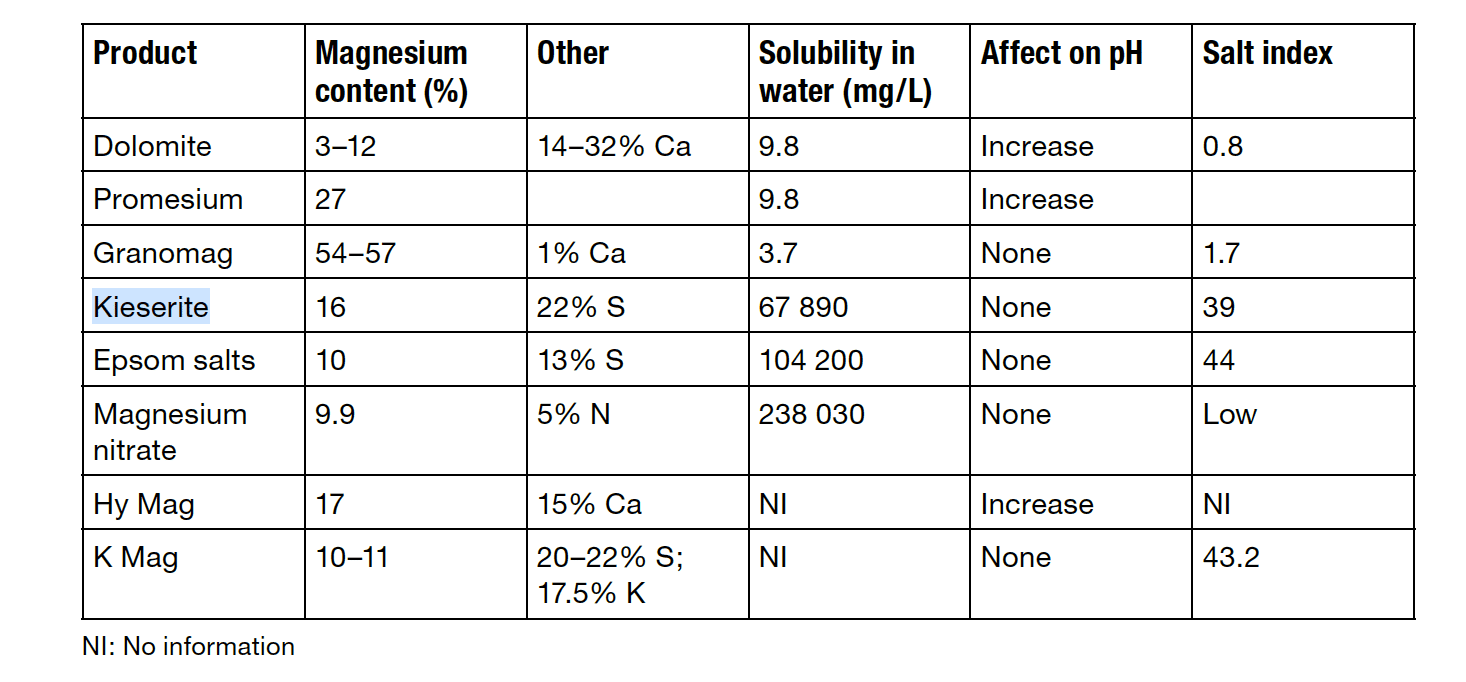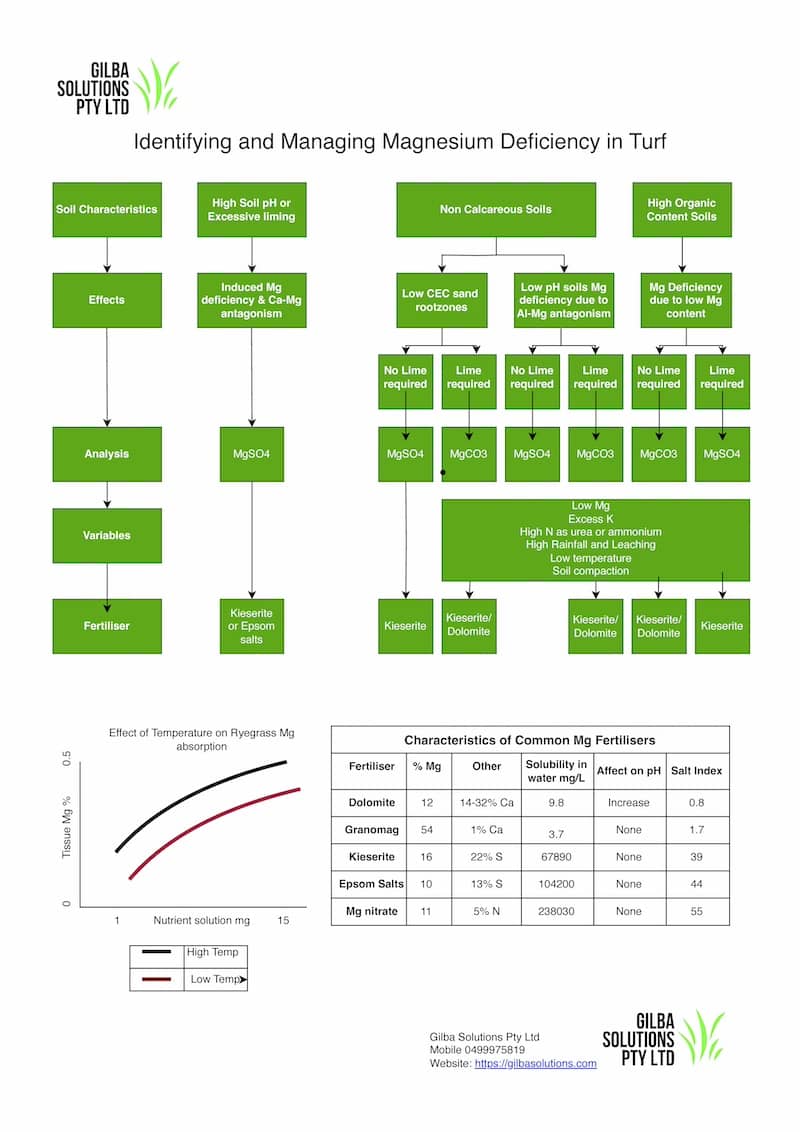Magnesium Fertilizers.
Magnesium is often used as a turf fertilizer. Common options include Kieserite fertilizer, Magnesium sulphate fertilizer and Magnesium oxide to manage Magnesium deficiency in plants. But which of these is the best option to address any magnesium deficiency? How do you know what is the best magnesium fertilizer to use in specific soil conditions?
The form of Mg fertilizer has a big effect on the results you get in a fertilizer strategy. For example, in soluble forms the tank compatibility of these varies dramatically.
The Role of Magnesium In the Plant.
The leaves of turfgrass on average contain around 2.1 g/kg (ppm).1Waddington, DV. and Zimmerman, TL. 1972. Growth and chemical composition of eight grasses grown under high water table conditions. Communications in Soil & Plant Analysis 3(4):329-337.
There are far higher levels of Calcium and Phosphorus in turf but this is about the same as the Sulphur content.
In reality there is a strong suggestion that in turf Magnesium may often be highly deficient due to the sufficiency level on average being greater than 2 g/kg.
- Magnesium (Mg2+) is important for the health, growth, and vigour of turfgrass. It is integral for photosynthesis as it is for chlorophyll formation.
- The pigment in plants that absorbs light is called Chlorophyll. Chlorophyll absorbs blue and red light waves and reflects green light waves, and is what gives plants their green colour.
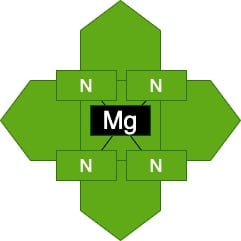
- Magnesium is the central atom of chlorophyll, although only a fraction (25%) of the total Magnesium is bound to chlorophyll. The balance (about 70%) remains relatively mobile in the plant, and is present in plant sap.
- Magnesium influences over 300 enzymes in turfgrass.
- The uptake of nutrients like N and P needs Magnesium to occur efficiently.
- Magnesium improves the transport of P in turf.
- Recent research, shows the importance of Magnesium2Rengel, Z, Bose, J, Chen, Q, Tripathi, BN. (2015). Magnesium alleviates plant toxicity of aluminium and heavy metals. Crop Pasture Sci. 66, 1298–1307. doi: 10.1071/CP15284 in improving plant tolerance against several environmental stressors.
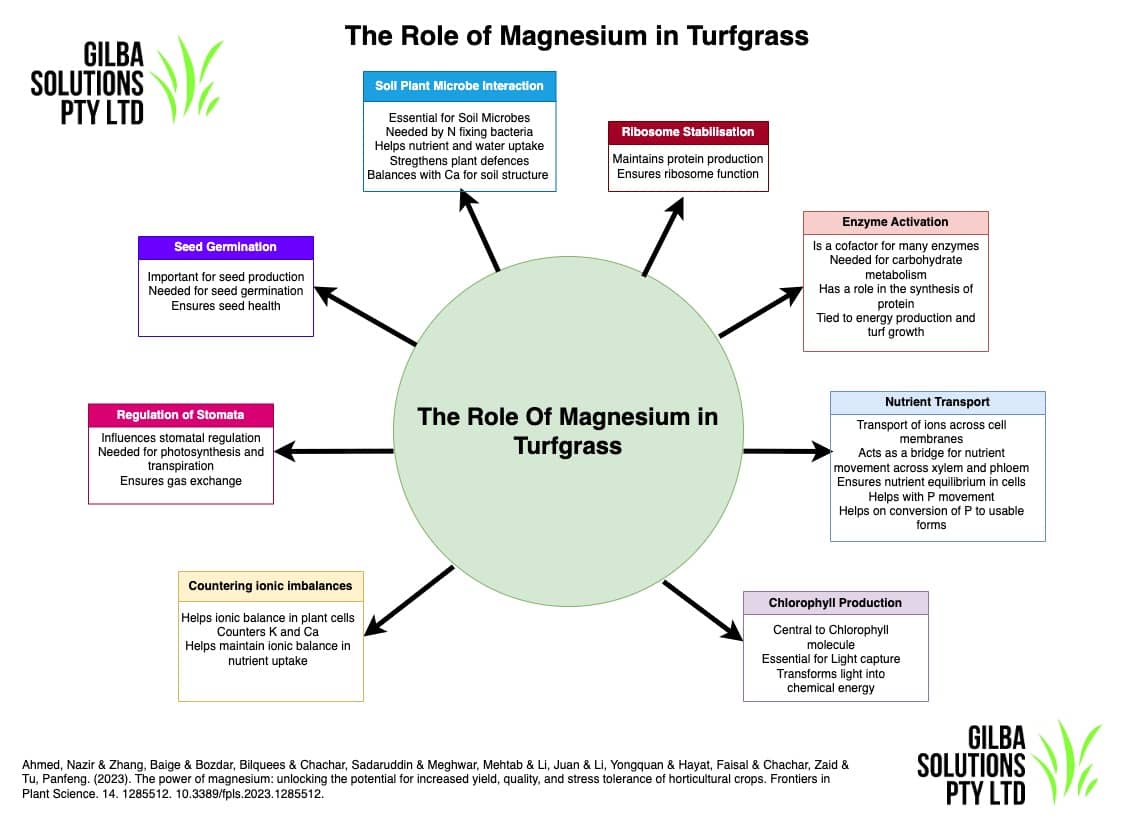
Symptoms of Magnesium Deficiency in plants.
- You often see Magnesium deficiency in plants as interveinal chlorosis. Interveinal chlorosis, is a yellowing between the the leaf veins. The veins remain green.
- The key to identifying if you have a Magnesium deficiency, is where you find this chlorosis, as it is often confused with Iron deficiency.
- As Magnesium is highly mobile in the plant, the first signs of Magnesium deficiency appear on the older, lower leaves. This is because the Magnesium moves towards new growth.
Magnesium Deficiency in turfgrass.
- Cations like as ammonium, Potassium, and Calcium plus a low soil pH all reduce Magnesium uptake.
- Heavy liming and high rates of Calcium or Potassium fertilizer, without any additional Magnesium, will cause a Magnesium deficiency. This “induced” deficiency, is seldom considered when people apply potassium fertilizers.
- Heavy irrigation can also tend to leach Magnesium out of the root zone. This is likely in sandy soils.
Table of Magnesium Nutrient Antagonism3René PJJ. Rietra, Heinen M, Dimkpa CO & Bindraban PS (2017) Effects of Nutrient Antagonism and Synergism on Yield and Fertilizer Use Efficiency, Communications in Soil Science and Plant Analysis, 48:16, 1895-1920, DOI: 10.1080/00103624.2017.1407429.
Excess | Effects |
Magnesium | Calcium, Potassium |
Manganese | Iron, Magnesium |
Nitrogen | Potassium, Calcium |
Phosphorus | Zinc, Iron, Copper |
Potassium | Nitrogen, Magnesium, Calcium |
Iron | Manganese |
Sodium | Potassium, Calcium, Magnesium |
Copper | Iron, Manganese, Zinc |
Calcium | Boron, Phosphorus, Magnesium |
Zinc | Iron, Manganese |
Sulphur | Manganese, Iron, Zinc |
Low levels of soil Magnesium cause a reduction in the root: shoot ratio (weight of roots/weight of shoots)4Cakmak I, Magnesium in Crop Production, Food Quality and Human Health. 2013. Plant and Soil 368(1-2) DOI:10.1007/s11104-013-1781-2.
The end result is a poor root system which directly impacts the wear tolerance of turfgrass.
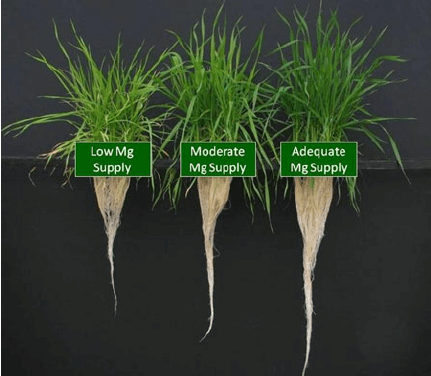
Soil type.
Both soil texture and soil organic matter play a role in the availability of Magnesium. What sort of clay is present also has an influence. Even though a soil may contain a similar clay content, the magnesium availability can vary.
Soils that contain a high content of kaolinitic clay, that are sandy, and have a low organic matter content will need more frequent magnesium fertilization.
This is in contrast to heavy soils, and those with a high CEC. These generally need larger and less frequent applications.
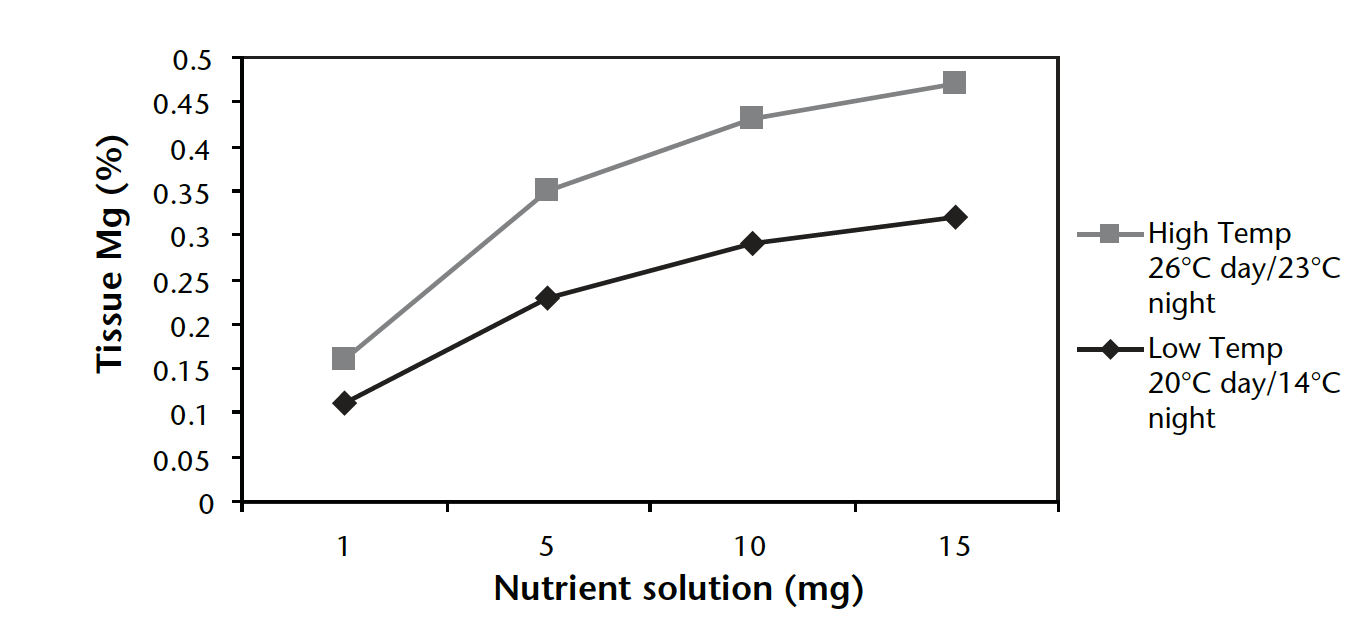
When does Magnesium Deficiency occur?
The following conditions inhibit Magnesium uptake:
- Excess irrigation or heavy rainfall.
- Sandy and low CEC soils.
- After you apply high rates of lime.
- In acidic (low pH) soil. Low soil pH soils lock up Magnesium as it reduces Magnesium solubility. This makes it less available
- High rates of potassium fertilizer.
- In cold and wet weather.
- When you box off clippings this leads to a gradual fall in soil levels of Magnesium.
When to Use a Magnesium Fertilizer:
- When soil Magnesium levels are low.
- When the existing soil pH is high, or you use lime to address low pH soils.
- You use ammonium Nitrogen. This can cause an antagonism between the ammonium and the Magnesium.
- If the soil is compact.
- In periods of wet/cold weather it can lead to lower mobility of Magnesium in the soil.
Common Magnesium Fertilizers.
To decide on which Magnesium fertilizer to use you must know their specific characteristics. These can be quick-release soluble salts such as Magnesium sulphate fertilizer and Magnesium nitrate or slow-release forms like Magnesium oxide.
Quick-release Magnesium Fertilizers.
- Magnesium sulphate fertilizer, in the form of Epsom salts (10% magnesium).
- Magnesium nitrate (11% magnesium).
Epsom salts contain 10% magnesium and are also known as Magnesium sulphate fertilizer. It is highly soluble and prevents and corrects any Magnesium deficiency in plants. However, due to its high solubility, it tends to leach, especially on sandy soils.
Magnesium nitrate contains 10% nitrogen and 11% magnesium. When you use Magnesium nitrate as a foliar it is an ideal way to deliver Magnesium and nitrate-N.
In fact you can reduce rates by 30 to 50% in comparison to Epsom salts (Magnesium sulphate). It is sulphate-free, and does not have issues with tank compatibility.
However, due to its high solubility this tends to rapidly leach rapidly out of sandy soils.
Use of Foliar Magnesium.
- When soil conditions or the root system limit Magnesium uptake, foliars allow you to rapidly correct any deficiencies..
- When you use Magnesium fertilizers as foliars, Magnesium ions are taken up by turf via their leaf stomata.
- Once they enter the leaf, Magnesium moves to other parts of the plant because it is very mobile. This includes the roots and any new growth.
Medium-release Magnesium Fertilizers.
- Kieserite fertilizer (16% magnesium).
-
When Magnesium is in the chelated form it is bound to an organic molecule. This makes it more readily available for plants, and is especially the case in high pH soils.
Kieserite fertilizer, a less soluble form of Magnesium sulphate, and is pH-neutral. It does not acidify the soil.
The other advantage of Kieserite is that it also contains 20 % S. The addition of S, guarantees turf is better able to utilise N.
Slow-release Magnesium Fertilizers.
- Calcium Magnesium carbonate, known as dolomitic lime. This contains 3–12% Magnesium.
- ,Granomag® which is Magnesium oxide, contains 57% magnesium.
Granomag contains 57% Magnesium as Magnesium oxide and is often in fertilizer blends. However, it is insoluble, and not readily available to the turf as it takes so long to break down.
The other disadvantage is due to its large particle size. It is no good to use on close cut turf, such as greens. However it’s fine to use during renovation after hollow tine aeration if you work it down the tine holes.
Why Use Kieserite Fertilizer?
- It produces a consistent supply of Magnesium.
- The release pattern of Kieserite fertilizer matches turf demand.
- As Kieserite moves down through the soil profile, it optimizes uptake.
- It is user-friendly. It is available as a granule or a fine powder.
References

Jerry Spencer
Graduated from Newcastle University with an Hons Degree in Soil Science in 1988, Jerry then worked for the Sports Turf Research Institute (STRI) as a turf agronomist before emigrating to Australia in 1993.
He followed this by gaining a Grad Dip in Business Management from UTS. He has worked in a number of management roles for companies as diverse as Samsung Australia, Arthur Yates and Paton Fertilizers.
He has always had a strong affinity with the Australian sports turf industry and as a result he established Gilba Solutions as an independent sports turf consultancy in 1993. Jerry has written over 100 articles and two books on a wide range of topics such as Turf Pesticides and Nutrition which have been published in Australia and overseas.


